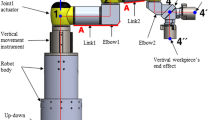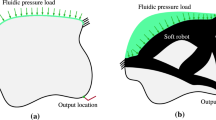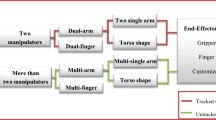Abstract
Optimum design is a key approach to make full use of potential advantages of a parallel manipulator. The optimum design of multi-parameter parallel manipulators(more than three design parameters), such as Stewart manipulator, relies on analysis based and algorithm based optimum design methods, which fall to be accurate or intuitive. To solve this problem and achieve both accurate and intuition, atlas based optimum design of a general Stewart parallel manipulator is established, with rational selection of design parameters. Based on the defined spherical usable workspace(SUW), primary kinematic performance indices of the Stewart manipulator, involving workspace and condition number are introduced and analyzed. Then, corresponding performance atlases are drawn with the established non-dimensional design space, and impact of joint distribution angles on the manipulator performance is analyzed and illustrated. At last, an example on atlas based optimum design of the Stewart manipulator is accomplished to illustrate the optimum design process, considering the end-effector posture. Deduced atlases can be flexibly applied to both quantitative and qualitative analysis to get the desired optimal design for the Stewart manipulator with respect to related performance requirements. Besides, the established optimum design method can be further applied to other multi-parameter parallel manipulators.
Similar content being viewed by others
References
TANG X, TANG L, WANG J, et al. Workspace quality analysis and application for a completely restrained 3-DOF planar cable-driven parallel manipulator[J]. Journal of Mechanical Science and Technology, 2013, 27(8): 2391–2399.
HOSTENS I, ANTHONIS J, RAMON H. New design for a 6 DOF vibration simulator with improved reliability and performance[J]. Mechanical Systems and Signal Processing, 2005, 19(1): 105–122.
LI B, CAO Y, ZHANG Q, et al. Orientation-singularity representation and orientation-capability computation of a special class of the Gough-Stewart parallel mechanisms using unit quaternion[J]. Chinese Journal of Mechanical Engineering, 25(6): 1096–1104.
STAICU S, ZHANG D. Dynamic modeling of a 4-DOF parallel kinematic machine with revolute actuators[J]. International Journal Manufacturing Research, 2008, 3(2): 172–187.
LIU X J, WANG J, ZHENG H J. Optimum design of the 5R symmetrical parallel manipulator with a surrounded and good-condition workspace[J]. Robotics and Autonomous Systems, 2006, 54(3): 221–233.
YAO R, TANG X, WANG J, et al. Dimension optimization design of the four-cable driven parallel manipulator in FAST[J]. IEEE/ASME Transactions on Mechatronics, 2010, 15(6): 932–941.
TANG X, YAO R. Dimensional design on the six-cable driven parallel manipulator of FAST[J]. Journal of Mechanical Design, 2011, 11: 1–12.
CECCARELLI M, LANNI C. A multi-objective optimum design of general 3R manipulators for prescribed workspace limits[J]. Mechanism and Machine Theory, 2004, 39(2): 119–132.
GAO Z, ZHANG D, GE Y. Design optimization of a spatial six degree-of-freedom parallel manipulator based on artificial intelligence approaches[J]. Robotics and Computer-Integrated Manufacturing, 2010, 26(2): 180–189.
WANG B, HAN W. Performance atlases of global conditioning index of planar 3-DOF parallel manipulator with accuracy redundancy[J]. Advanced Materials Research, 2012, 479–481: 2316–2320.
LIU X J, WANG J, PRITSCHOW G. Performance atlases and optimum design of planar 5R symmetrical parallel mechanisms[J]. Mechanism and Machine Theory, 2006, 41(2): 119–144.
GAO F, ZHANG X, ZHAO Y, et al. A physical model of the solution space and the atlases of the reachable workspaces for 2-DOF parallel plane wrists[J]. Mechanism and Machine Theory, 1996, 31(2): 173–184.
MERLET J P, GOSSELIN C M, MOULY N. Workspaces of planar parallel manipulators[J]. Mechanism and Machine Theory, 1998, 33(1, 2): 7–20.
MERLET J P. Determination of 6D workspaces of Gough-type parallel manipulator and comparison between different geometries[J]. International Journal of Robotics Research, 1999, 18(9): 902–916.
MERLET J P. Designing a parallel manipulator for a specific workspace[J]. International Journal of Robotics Research, 1997, 16(4): 545–556.
HAY A M, SNYMAN J A. Methodologies for the optimal design of parallel manipulators[J]. International Journal for Numerical Methods in Engineering, 2004, 59(3): 131–152.
BAI S. Optimum design of spherical parallel manipulators for a prescribed workspace[J]. Mechanism and Machine Theory, 2010, 45(2): 200–211.
KLEIN C A, BLAHO B E. Dexterity measures for the design and control of kinematically redundant manipulator[J]. International Journal of Robotics Research, 1997, 6(2): 72–83.
SALISBURY J K, GRAIG J J. Articulated hands: force control and kinematic issues[J]. International Journal of Robotics Research, 1982, 1(1): 4–17.
LIU X J, JIN Z L, GAO F. Optimum design of 3-DOF spherical parallel manipulators with respect to the conditioning and stiffness indices[J]. Mechanism and Machine Theory, 2000, 35(9): 1257–1267.
GAO F, LIU X J, GRUVER W A. Performance evaluation of two degree-of-freedom planar parallel robots[J]. Mechanism and Machine Theory, 1998, 33(6): 661–668.
TANG X, SHAO Z. Trajectory planning and tracking control of a multi-level hybrid support manipulator in FAST[J]. Mechatronics, 2013, 23(8): 1113–1122.
YAO R, ZHU W, HUANG P. Accuracy analysis of Stewart platform based on interval analysis method[J]. Chinese Journal of Mechanical Engineering, 2013, 26(1): 29–34.
SHAO Z, TANG X, CHEN X, et al. Research on the inertia matching of the Stewart parallel manipulator[J]. Robotics and Computer-Integrated Manufacturing, 2012, 28(6): 649–659.
GOSSELIN C, ANGELES J. Singularity analysis of closed-loop kinematic chains[J]. IEEE Transaction on Robotics and Automation, 1990, 6(3): 281–290.
MA O, ANGELS J. Architecture singularities of platform manipulators[C]// Proceedings of the IEEE International Conference on Robotics and Automation, Sacramento, California, USA, April, 9–11, 1991: 1542–1547.
MA J, HUANG Q, XIONG H, et al. Analysis and application of the singularity locus of the Stewart platform[J]. Chinese Journal of Mechanical Engineering, 2011, 24(1): 133–140.
Author information
Authors and Affiliations
Corresponding author
Additional information
Supported by National Natural Science Foundation of China(Grant Nos. 51205224, 51475252), and National Outstanding Youth Science Foundation of China(Grant No. 51225503)
SHAO Zhufeng, born in 1983, is currently an assistant professor at Department of Mechanical Engineering, Tsinghua University, China. He received his PhD degree from Tsinghua University, China, in 2011. His research interests include design, dynamic analysis and control of the parallel manipulator.
TANG Xiaoqiang, born in 1973, is currently an associate professor and a PhD candidate supervisor at Department of Mechanical Engineering, Tsinghua University, China. His main research interests include parallel manipulator, cable robots, and motion control.
WANG Liping, born in 1967, is currently a professor and a PhD candidate supervisor at Department of Mechanical Engineering, Tsinghua University, China. His main research interests lie in the advanced manufacturing equipment.
SUN Dengfeng, born in 1975, is currently an associate professor at School of Aeronautics and Astronautics Engineering, Purdue University, USA. His main research interests include modeling, simulation and optimization of large scale networked systems.
Rights and permissions
About this article
Cite this article
Shao, Z., Tang, X., Wang, L. et al. Atlas based kinematic optimum design of the Stewart parallel manipulator. Chin. J. Mech. Eng. 28, 20–28 (2015). https://doi.org/10.3901/CJME.2014.0929.155
Received:
Revised:
Accepted:
Published:
Issue Date:
DOI: https://doi.org/10.3901/CJME.2014.0929.155




